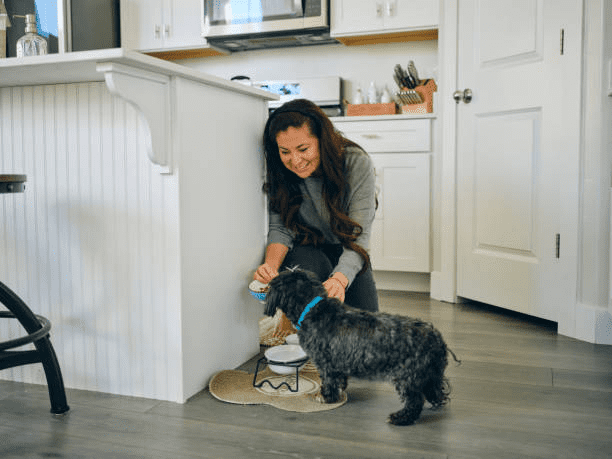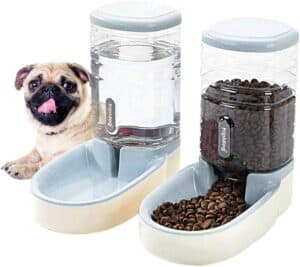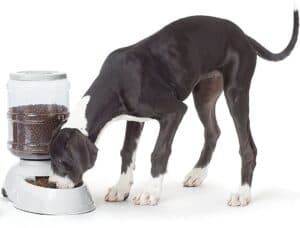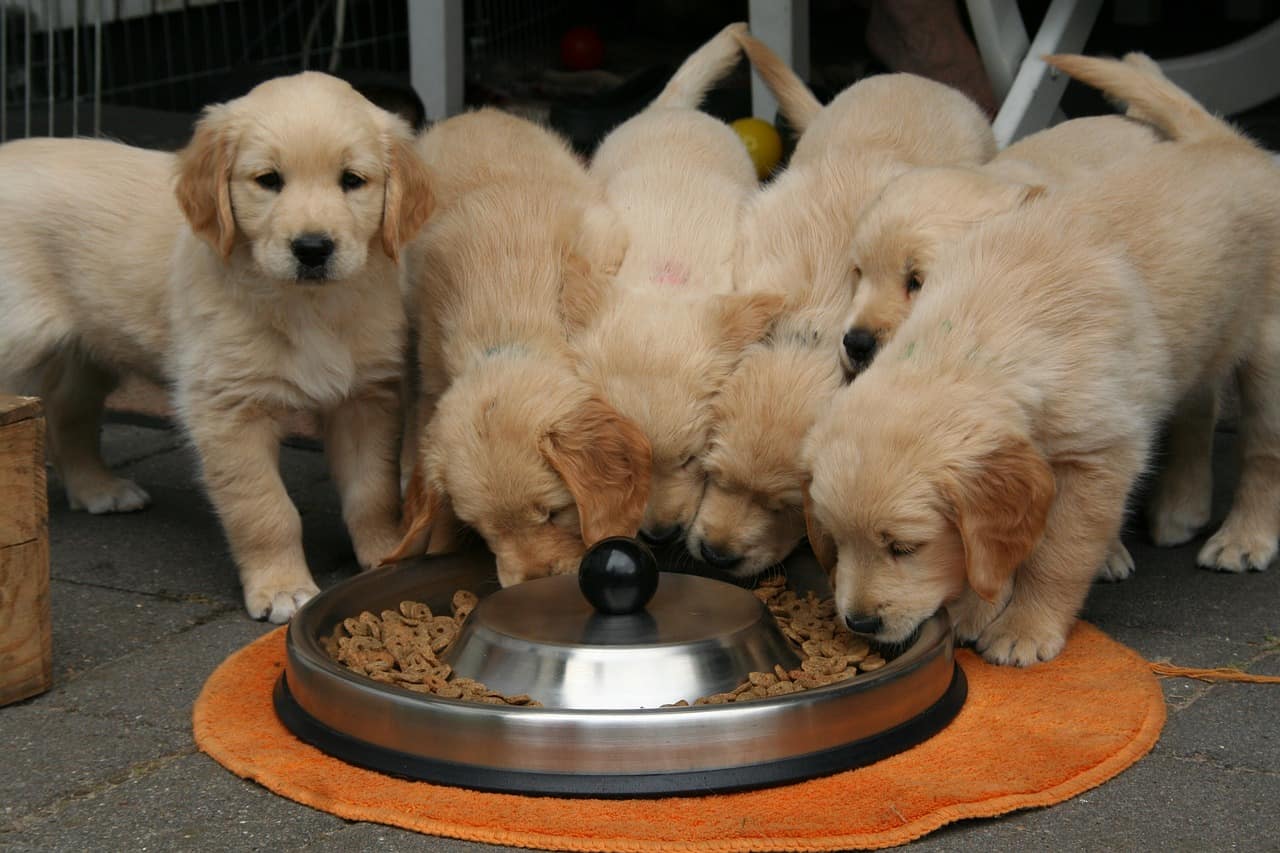Are you tired of worrying about your furry friend’s meal times while you’re away at work? Or do you constantly find yourself rushing home to feed your pet, even when your schedule is packed? Enter automatic dog feeders – the lifesaver for pet owners everywhere. These modern gadgets have revolutionized the way we care for our dogs, making it easier than ever to ensure they receive timely, consistent meals, even when we’re not around.
With a range of features and styles to choose from, automatic dog feeders are the perfect solution for busy pet owners who want to provide their furry friends with the best possible care.
So why not say goodbye to mealtime stress and embrace the convenience of automatic dog feeders? Let’s explore all the benefits and features these devices have to offer and discover why they’re a must-have for any dog owner.

How Do Automatic Dog Feeders Work?
Automatic dog feeders work by dispensing a pre-determined amount of food at a set time. The feeder is typically set up with a reservoir or hopper that holds the food, and a dispenser that releases the food into a bowl or tray for the dog to eat.
Some automatic feeders use a timer to release the food at pre-set times, while others may be programmable with specific feeding schedules. Some advanced feeders even come with smart features, allowing you to control and monitor your dog’s feeding from a mobile app.
Most automatic feeders are powered by either batteries or electricity and can hold enough food to last for several days. This can be especially useful for pet owners who are away from home for long periods, as it ensures their dogs receive timely and consistent feedings even when they’re not around.
Overall, automatic dog feeders are a convenient and practical solution for pet owners who want to maintain a regular feeding schedule for their dogs. They provide precise portion control and can help prevent overeating, which can lead to various health issues.

Benefits of Using an Automatic Dog Feeder
Using an automatic dog feeder offers a range of benefits for both the dog and the owner. One of the most significant advantages of automatic feeders is the consistency and timeliness of meals. Dogs thrive on routine and having a set feeding schedule helps regulate their appetite, digestion, and energy levels. With an automatic feeder, pet owners can ensure that their furry friend receives meals on time, even when they’re not at home.
Portion control is another essential benefit of using an automatic dog feeder. Overfeeding is a common problem that can lead to obesity and other health issues in dogs.
According to a survey by the Association for Pet Obesity Prevention, an estimated 60% of dogs in the United States are overweight or obese. This puts them at risk of various health problems, including arthritis, diabetes, and heart disease.
Automatic feeders can help prevent overeating and promote healthy weight management by dispensing the correct portion size at each meal. This is especially important for dogs who tend to overeat or who are prone to weight gain. Automatic feeders can also help prevent food stealing or food aggression between multiple pets in a household, ensuring that each pet gets the appropriate amount of food.
In addition to promoting proper weight management, using an automatic dog feeder also offers convenience for busy pet owners. With an automatic feeder, pet owners can program the device to dispense meals at specific times, even when they’re away from home. This makes it easier to maintain a consistent feeding schedule, which is important for a dog’s overall health and well-being.
In summary, the benefits of using an automatic dog feeder include:
- Consistency and timeliness of meals
- Portion control for weight management
- Convenience for busy schedules
By utilizing automatic feeders, pet owners can take an important step towards ensuring their furry friend’s optimal health and well-being.
Related Post: Puppy Socialization Stage.
Factors to Consider Before Choosing an Automatic Dog Feeder
When shopping for an automatic dog feeder, it’s important to consider several factors to ensure that you select the right feeder for your dog’s needs. Here are some factors to consider before making your purchase:
Dog’s Age, Breed, and Weight:
The age, breed, and weight of your dog are important considerations when choosing an automatic dog feeder. Different breeds and sizes of dogs require different amounts of food, and their feeding needs may also change as they age. Puppies and older dogs may have different dietary requirements than adult dogs.
Moreover, dogs that are overweight or underweight require specialized feeding schedules and portion sizes. Make sure to consider your dog’s unique feeding requirements and choose an automatic feeder that can meet those needs.

Type of Food and Feeding Schedule:
Another factor to consider is the type of food you feed your dog and their feeding schedule. Different types of food may require different feeding schedules or portion sizes.
For instance, dogs fed a raw food diet may need to eat multiple small meals throughout the day, while dogs fed kibble may only need two or three larger meals per day.
Some dogs may need to eat at specific times due to medication or health issues. Consider your dog’s dietary needs and feeding schedule to choose an automatic feeder that can accommodate them.
Feeder Features and Functionalities:
Consider the features and functionalities of the automatic feeder. Some feeders may offer portion control, while others may allow you to dispense food on-demand or on a timer. Some feeders may even come with a built-in camera, allowing you to monitor your dog while they eat.
Other factors to consider include the size of the feeder, the materials used in its construction, and whether it is easy to clean and maintain. Make sure to choose a feeder that offers the features and functionalities that are important to you and your pet.
Tips for Transitioning Your Dog to an Automatic Feeding Schedule
Transitioning your dog to an automatic feeding schedule can take some time, especially if your dog is used to being fed on demand. Here are some tips to help make the transition smoother:
Start gradually:
Start by introducing the automatic feeder to your dog gradually. Begin by setting up the feeder without food and allow your dog to investigate it. Once your dog is comfortable with the feeder, start by feeding them one meal a day from the automatic feeder and continue to feed the remaining meals in their usual way.
Keep your dog’s feeding schedule consistent:
If your dog is used to eating at a specific time, try to keep that schedule as consistent as possible. Gradually adjust the time of feeding to match the automatic feeder’s schedule.
Measure the amount of food:
One of the benefits of an automatic feeder is precise portion control. To ensure your dog is getting the correct amount of food, measure the food before filling the feeder.
Monitor your dog’s eating behavior:
Observe your dog’s eating behavior during the transition. Some dogs may need time to adjust to the new feeding schedule or may need encouragement to eat from the automatic feeder. If your dog is having difficulty adjusting, try adding a little bit of food to the bowl or offering treats near the feeder.
Make sure the feeder is clean:
Regularly clean the automatic feeder to ensure it’s free of bacteria and mold. Follow the manufacturer’s cleaning instructions, and consider using a dishwasher-safe feeder to make cleaning easier.
Don’t forget to hydrate your dog:
If your dog is not used to an automatic watering schedule, make sure to offer water throughout the day.
By following these tips, you can help your dog transition to an automatic feeding schedule smoothly and with minimal stress. Remember to be patient and observe your dog’s behavior throughout the transition.

Types of Automatic Dog Feeders
There are different types of automatic dog feeders, and each type has its own benefits and disadvantages. Here are the types of automatic dog feeders and when to use them:
| Type of Automatic Dog Feeders | Pros | Cons |
| Gravity Feeders | Easy to use, low maintenance | No portion control, no scheduling options |
| Electronic Timed Feeders | Precise portion control, scheduling options | Require power source, limited food capacity |
| Clamshell-Style Feeders | Dry, moist, or wet food, one or more compartments | Potential to break |
| Smart Feeders | Remote control and monitoring, personalized feeding options | Expensive, and require an internet connection |
Gravity feeders
Gravity feeders are the most basic type of automatic dog feeder. They work by holding the food in a container, and the food drops into the bowl as the dog eats. This type of feeder is suitable for dogs that don’t overeat, and pet owners who want an affordable and straightforward solution. However, gravity feeders cannot regulate the amount of food dispensed, which makes them unsuitable for dogs on a strict diet.
Benefits:
Simple and affordable
No electricity or programming required
Disadvantages:
Cannot regulate the amount of food dispensed
Not ideal for dogs on a strict diet
Programmable feeders
Programmable feeders are the most common type of automatic dog feeder. They work by allowing pet owners to program feeding schedules and portion sizes. This type of feeder is ideal for pet owners who want to control their dog’s diet or have a busy schedule that doesn’t allow for regular feedings.
However, some programmable feeders can be complicated to program and may require electricity or batteries.
Benefits:
Precise portion control
Ideal for pet owners with busy schedules
Convenient for controlling the dog’s diet
Disadvantages:
Some models may be complicated to program
Requires electricity or batteries
Smart feeders
Smart feeders are a more advanced type of automatic dog feeder. They work by connecting to the internet via Wi-Fi and allowing pet owners to monitor and control feedings via a mobile app. Some smart feeders can also dispense food on-demand, record video or audio, and provide notifications when food levels are low.
This type of feeder is ideal for pet owners who want to stay connected to their dogs while away from home. However, smart feeders are the most expensive type of feeder and may require more maintenance.
Benefits:
Control and monitor feedings remotely
On-demand feeding, video or audio recording, and low food level notifications
Disadvantages:
Expensive
Requires maintenance
Clamshell-Style Feeders
These feeders are designed for wet and dry food. They work by using an ice pack or refrigeration system to keep the food fresh until it’s time to eat. It’s ideal for pet owners who want to ensure their dog’s food stays fresh while they’re away. However, they require more maintenance to keep clean.
Advantages
Ideal for dogs that eat wet food
Keep food fresh
Disadvantages:
More expensive than other types of feeders
Requires more maintenance to keep clean
And there’s also an automatic dog feeder for multiple dogs. It comes with a 2 or 3-way splitter and can divide meals equally, and feed multiple pets at the same time.
By understanding the different types of automatic dog feeders and their benefits and disadvantages, pet owners can choose the right feeder that fits their lifestyle and meets their dog’s feeding requirements.
FAQs
Is It Ok To Leave Your Dog Food Out All Day?
No, it is not ok to leave your dog food out all day. This is because your pup may end up overeating if the food is left out for long periods of time. Additionally, the food can become stale or contaminated with bacteria or other organisms that can make your pooch sick.
It’s best to provide meals at regular intervals and store away all leftover servings after each meal to ensure safety and optimal nutrition.
Do dogs stop eating when full?
Dogs will usually stop eating when they feel full, however, this is not always the case. Some breeds of dogs, such as Labradors, are known for having a voracious appetite and may not naturally know when to stop if there is plenty of food available.
It’s important to monitor how much food your dog eats and be careful not to overfeed them. Providing regular walks and playtime with your pet can also help them to maintain a healthy weight by burning off excess energy.
How often should a dog eat?
Dogs should typically be fed two to three times per day, with specific guidelines depending on their age, breed, and size. Puppies up to 6 months old need to be fed three times a day, while those aged 6 months to 1 year can be fed twice a day.
Adult dogs should be served two meals each day and senior dogs can usually get away with one meal per day. The portions will also depend on the type of food being fed; consult your vet or nutritionist for exact amounts that match the individual needs of your dog.
Final Thoughts on Automatic Dog Feeders
In conclusion, automatic dog feeders can be an excellent tool for pet owners to ensure their dogs are getting the right amount of food at the right time. By considering factors such as their age, breed, and weight, as well as the type of food and feeding schedule, and choosing the right feeder, you can put your dog on the perfect meal plan.
With the increasing rate of dog obesity, it’s essential to take control of your dog’s diet and feeding habits. Automatic feeders can help promote healthy eating habits and prevent overeating, which can lead to various health issues.
However, it’s important to remember that automatic feeders are just one part of the puzzle. Consistency, portion control, and monitoring your dog’s behavior are also crucial to ensuring a healthy feeding routine.
So, whether you decide to use an automatic feeder or stick with traditional feeding methods, the key is to prioritize your dog’s health and well-being. As responsible pet owners, we have a duty to ensure our dogs receive the proper nutrition and care they need to live happy and healthy lives.
Recent Posts
As a dog owner, you want to ensure that you take proper care of your furry companion. A common question that many pet owners have is, "Can I walk my dog 30 minutes after eating?" Understanding the...
Have you ever considered getting an elevated dog bed for your furry friend, but wondered if it's worth the investment? If so, you're not alone. As dog owners, we all want to provide the best care for...

